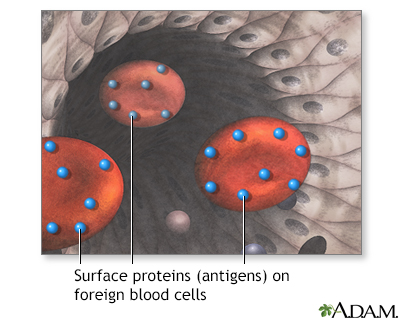Pregnancy SmartSiteTM
Blood transfusion reaction; Transfusion reaction DefinitionA hemolytic transfusion reaction is a serious complication that can occur after a blood transfusion. The reaction occurs when the red blood cells that were given during the transfusion are destroyed by the person's immune system. When red blood cells are destroyed, the process is called hemolysis. There are other types of transfusion reactions that do not cause hemolysis, such as febrile (causing fever) transfusion reactions. CausesBlood is classified into four different types: A, B, AB, and O. Another way blood cells may be classified is by Rh factors. People who have Rh factors in their blood are called "Rh positive." People without these factors are called "Rh negative." Rh negative people form antibodies against Rh factor if they receive Rh positive blood. There are also many other blood-related factors that differ among people, in addition to ABO and Rh. Your immune system can usually tell its own blood cells from those of another person. If you receive blood that is even partially not compatible with your blood, your body produces antibodies to destroy the donor's blood cells. This process causes the transfusion reaction. Blood that you receive in a transfusion must be compatible with your own blood. This means that your body does not have antibodies against the blood you receive. Most of the time, a blood transfusion between compatible groups (such as O+ to O+) does not cause a problem. However, minor mismatches in blood factors can cause a reaction. It is usually mild. Blood transfusions between incompatible groups (such as A+ to O-) cause an immune response. This can lead to a serious transfusion reaction. The immune system attacks the donated blood cells, destroying them. Today, all blood is carefully screened. Transfusion reactions are rare. SymptomsSymptoms may include any of the following:
Symptoms of a hemolytic transfusion reaction most often appear during or right after the transfusion. Sometimes, they may develop after several days (delayed transfusion reaction). Exams and TestsThis disease may change the results of these tests:
TreatmentIf symptoms occur during the transfusion, the transfusion must be stopped right away. Blood samples from the recipient (person getting the transfusion) and from the donor must be tested to tell whether symptoms are being caused by a transfusion reaction. Mild symptoms may be treated with:
Outlook (Prognosis)The outcome depends on how severe the reaction is. The disorder may run its course without problems. Or, it may be severe and life threatening. Possible ComplicationsComplications may include:
When to Contact a Medical ProfessionalTell your health care provider if you are having a blood transfusion and you have had a reaction before. PreventionDonated blood is put into ABO and Rh groups to reduce the risk for transfusion reaction. Before a transfusion, recipient and donor blood are tested (cross-matched) to see if they are compatible. A small amount of donor blood is mixed with a small amount of recipient blood and tested to see if transfused cells are destroyed or clumped. Before the transfusion, your provider will usually check again to make sure you are receiving the right blood. ReferencesHall JE, Hall ME. Blood types; transfusion; and tissue and organ transplantation. In: Hall JE, Hall ME, eds. Guyton and Hall Textbook of Medical Physiology. 14th ed. Philadelphia, PA: Elsevier; 2021:chap 36. Schipperus MR, Wiersum-Osselton JC. Transfusion reactions to blood and cell therapy products. In: Hoffman R, Benz EJ, Silberstein LE, et al, eds. Hematology: Basic Principles and Practice. 8th ed. Philadelphia, PA: Elsevier; 2023:chap 117. Shaz BH, Hillyer CD. Transfusion medicine. In: Goldman L, Schafer AI, eds. Goldman-Cecil Medicine. 26th ed. Philadelphia, PA: Elsevier; 2020:chap 167. | |
| |
Review Date: 2/2/2023 Reviewed By: Mark Levin, MD, Hematologist and Oncologist, Monsey, NY. Review provided by VeriMed Healthcare Network. Also reviewed by David C. Dugdale, MD, Medical Director, Brenda Conaway, Editorial Director, and the A.D.A.M. Editorial team. The information provided herein should not be used during any medical emergency or for the diagnosis or treatment of any medical condition. A licensed medical professional should be consulted for diagnosis and treatment of any and all medical conditions. Links to other sites are provided for information only -- they do not constitute endorsements of those other sites. No warranty of any kind, either expressed or implied, is made as to the accuracy, reliability, timeliness, or correctness of any translations made by a third-party service of the information provided herein into any other language. © 1997- A.D.A.M., a business unit of Ebix, Inc. Any duplication or distribution of the information contained herein is strictly prohibited. | |

 Surface proteins c...
Surface proteins c...
